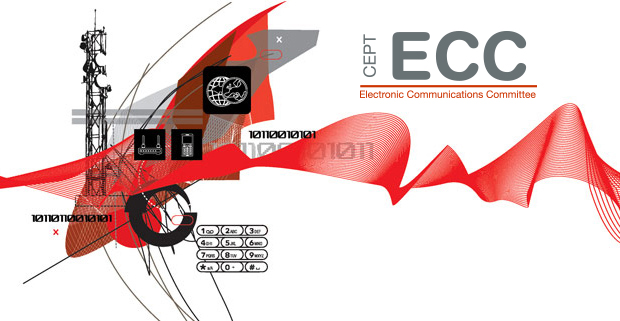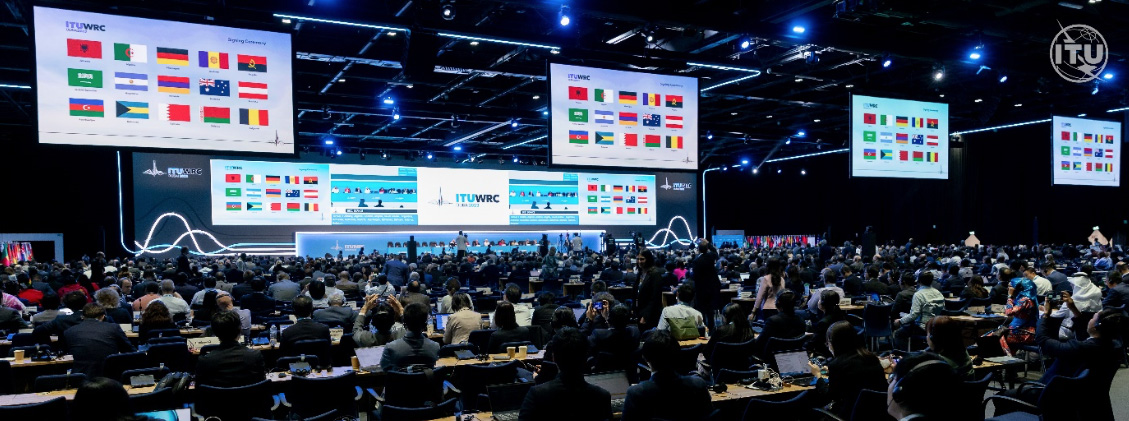ECC Newsletter January 2024
Conference agrees updated global regulations for 5G, satellite and other wireless applications
With thousands of attendees and some intense discussions, the month-long World Radiocommunication Conference 2023 paves the way for the technology of the future, writes ECO Expert Peter Faris
The headlines in December may have been dominated by COP28, the UN climate change conference, but across town in Dubai another major UN conference was working intensively to agree on emission limits of a different kind. The International Telecommunication Union (ITU) World Radiocommunication Conference (WRC-23) reached consensus on regulations to enable future wireless technologies while ensuring protection of existing services from interference.
WRC-23 took place over four weeks from 20 November to 15 December, bringing together almost 4000 participants, representing 163 ITU Member States, various international organisations and industry.
Figure 1: WRC-23 plenary session (source: ITU, CC BY-NC-SA 2.0)
The main objective of WRC, which takes place every four years, is to update the ITU Radio Regulations – an international treaty governing the use of radio spectrum internationally. The treaty allocates spectrum to different services in different frequency bands, with appropriate emission levels to ensure interference-free operation.
As technology evolves and the demand for new applications increases it is necessary to review these Regulations periodically. To this end, WRC-23 discussed 19 main agenda items covering proposals for new or updated allocations for mobile, satellite, maritime, aeronautical and scientific services, as well as other procedural matters such as management of satellite orbits.
The outcomes of studies on these topics during the previous four years were discussed, with consensus reached on all topics by the end of the Conference – including up to the very last moments in the case of the most contentious agenda items.
CEPT is one of six regional groups representing different regions of the world at the Conference. The CEPT coordination team worked tirelessly to promote and defend the European positions developed during the preparatory process, and to negotiate with representatives of the other regions. Successful outcomes were reached on several topics in line with the CEPT position going into WRC- 23, while it was necessary to compromise on other issues.
Figure 2: The CEPT coordination team at WRC-23 (source: ITU, CC BY-NC-SA 2.0)
Mobile – New frequencies for 5G and 6G
The Conference agreed proposals to improve and enable mobile technology. In ITU Region 1 (encompassing Europe, the Middle East and Africa), it agreed that the 6425-7125 MHz band would be identified for International Mobile Telecommunications (IMT). This will enable the use of 5G and future 6G technologies in this band, while taking into account appropriate measures to protect satellite networks from interference. The use of this band for Wi-Fi was also recognised, in line with ongoing work within ECC to facilitate sharing between these technologies. Additional IMT identifications were agreed in some countries and regions outside Europe in 3.3-3.4 GHz, 3.6-3.8 GHz and 10-10.5 GHz.
The Conference also agreed that existing mobile allocation in 3.6-3.8 GHz in Region 1 will be upgraded from secondary to primary status, which allows more flexibility in the use of this band, in line with the existing ECC framework (see December 2020 newsletter article).
The Conference identified various existing mobile bands below 3 GHz for “high altitude platforms operating as IMT base stations” (HIBS). This will enable unmanned aerial platforms such as airships to provide wide-area mobile coverage in remote unserved areas.
The status of 470-960 MHz (the UHF band) was reviewed, with a new secondary mobile allocation created in 470-694 MHz encompassing most CEPT countries. Possible further actions will be considered in the wider UHF band in eight years’ time at WRC-31. This solution allows for countries to deploy mobile networks to make use of the beneficial radio propagation properties in this frequency range and to provide wide area coverage, while ensuring that TV broadcasting can continue to use this band in other countries.
The Conference also agreed on how to adapt decades-old regulatory emission limits so they can be applied to modern 5G active antenna systems while ensuring protection of satellites from interference.
Figure 3: Delegates in the Conference venue (source: ITU, CC BY-NC-SA 2.0)
Satellite – Enabling new high speed applications and accommodating megaconstellations
The Conference reached several agreements to enable new satellite applications. It agreed regulatory measures to allow operation of "earth stations in motion" communicating with geostationary satellites in 12.75-13.25 GHz and non-geostationary satellites in portions of 17.7-20.2 GHz and 27.5-30 GHz. This built on the existing CEPT and global frameworks in these bands to enable a wider range of high-speed services to passengers on board aircraft and ships.
New frequency allocations were also agreed to support the operation of inter-satellite links in 18.1- 18.6 GHz, 18.8-20.2 GHz and 27.5-30 GHz.
The Conference also agreed on a wide range of updated measures related to the procedural aspect of management of satellite networks, in particular reflecting the need for updated regulatory measures to deal with the increase in demand for large constellations of non-geostationary satellites (see December 2022 newsletter article). The updated procedures for coordination and notification aim to facilitate wider access to satellite connectivity, including for new Member States, while ensuring protection of existing geostationary satellite networks.
Figure 4: CEPT coordination meetings during WRC-23
Scientific services – Protecting the needs of climate monitoring and space science applications
The Conference agreed on several measures to enable and protect important scientific applications including various European-funded projects related to climate monitoring.
A new secondary allocation to the earth exploration-satellite service (EESS) in 40-50 MHz was agreed, which will allow the use of spaceborne radar sounders to monitor the movement of polar ice sheets. The Conference also agreed on new EESS allocations in 239.2-242.2 GHz and 244.2-247.2 GHz to enable passive microwave sensing, including ice cloud imagery used in weather forecasting. It was agreed that existing allocations to fixed and mobile services in this range would be moved to 235-238 GHz to ensure interference-free operation. Limits were agreed for protection of EESS in 36- 37 GHz from interference from satellites in adjacent bands.
The Conference agreed that existing secondary allocation to the space research service in 14.8-15.35 GHz will be upgraded to primary status, which will facilitate the use of this band for satellite data relay systems. Such systems transmit scientific data between deep space missions, satellites and Earth, including communications with the International Space Station and possible use for lunar missions.
Solutions were agreed on how to enable sharing between satellite navigation and radio amateurs in the 1240-1300 MHz band, so that amateurs can continue to make use of this band without causing interference to Galileo satellite navigation receivers.
Aeronautical and maritime services – Enhancing communications in remote regions and over the seas
A range of solutions were agreed relating to aeronautical services. New allocations for aeronautical mobile-satellite in 117.975-137 MHz will enhance bi-directional communication between pilots and air traffic controllers flying over the oceans and remote continental regions. Meanwhile, new allocations were added for aeronautical mobile in 15.41-15.7 GHz and 22-22.2 GHz limited to non-safety communications, mainly for airborne sensors employed in various fields from agriculture to surveillance and disaster management.
On the maritime side, the Conference continued the work started at WRC-19 to support the modernisation of the Global Maritime Distress and Safety System (GMDSS). It reached consensus on a range of measures which take into account the work finalised in the meantime by he International Maritime Organization.
Setting the future agenda
Finally, one of the most intensive and challenging discussions surrounded the agenda for future conferences, which sets the work plan and priorities for the next four years towards WRC-27, as well as the preliminary agenda for WRC-31. This is explored in detail in the following article.
The final outcome was formally agreed through the signing of the Final Acts of the Conference by all participating Member States. It will be published in an updated version of the Radio Regulations during 2024.
Figure 5: The signing ceremony at WRC-23 (source: ITU, CC BY-NC-SA 2.0)
For more information on the outcome for the individual topics compared to the CEPT position, see the CEPT weekly reports from the Conference.








